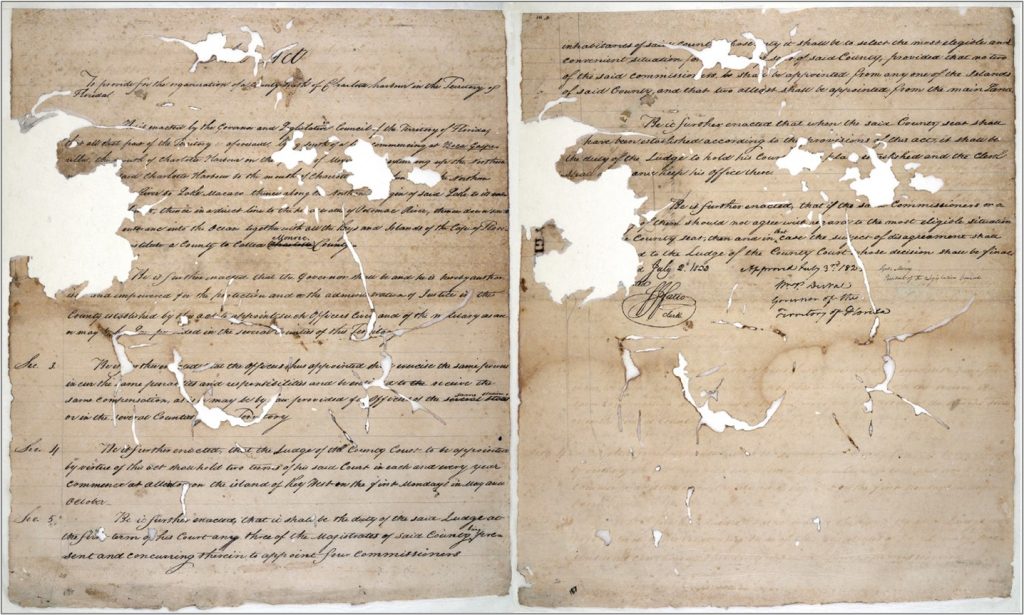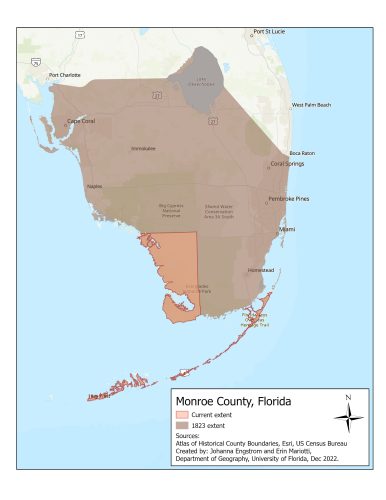Island Chronicles, vol. 1: The Establishment of Monroe County
Welcome to “Island Chronicles,” the Florida Keys History Center’s monthly feature dedicated to investigating and sharing events from the history of Monroe County, Florida. These pieces draw from a variety of sources, but our primary well is the FKHC’s archive of documents, photographs, diaries, newspapers, maps, and other historical materials. The FKHC’s mission is “to explore, preserve, promote, and make accessible the history of Monroe County, Florida,” and here we do just that.
By Corey Malcom, PhD
Lead Historian, Florida Keys History Center
In 1821, after centuries under Spanish control, Florida was ceded to the United States. In December of that year, Key West, in the Florida Keys off the southern end of the Florida peninsula, was purchased by American businessman John W. Simonton. Three months later, in 1822, Lt. Matthew Perry arrived onboard the USS Shark and raised the American flag over Key West, formally establishing the island as US territory and opening the port for commerce.
With that, while the Navy established a base and set out to rid the area of pirates, fledgling Keys communities began to grow. The resulting population increase created a need for a county at the southern end of the Florida territory: With Florida’s territorial administration seated at Tallahassee 600 miles away, the people of the Keys needed governmental structures and services without them being so distant.
On July 3, 1823, to accommodate the needs of the territory’s southernmost citizens, the Legislative Council of the Territory of Florida passed the act that established Monroe County. The now worm-eaten founding document titled “An Act To provide for the organization of a county south of Charlotte Harbour in the Territory of Florida” resides in the State Library and Archives of Florida.

Using antiquated geographical terminology, the decree stipulated that the new county – Florida’s sixth – would have a northern boundary that ran across the Florida Peninsula from Gasparilla Pass to the Peace River, along the northern shore of Lake Okeechobee, and then down to Hillsboro Inlet on the Atlantic coast. The new county took in every part of Florida south of that line, including the Florida Keys. Though the act does not explicitly state why, the new county was to be called “Monroe,” in honor of the 5th and then-current U.S. President James Monroe.
In a series of additional sub-sections, the act outlined the ways by which the new county was to be organized and administered, stipulating the ability of the governor to appoint county officials, the powers and limits of those officials, the establishment of a county court and seating of a judge at “Allenton” (Key West), the appointment process for commissioners and their residency requirements, and the way in which the county seat was to be established.
Because counties are intended to make state government accessible at a local level, as populations grow and spread, so does the idea of “locality.” As Florida’s populace expanded through the 19th century, new counties were created from those that had come before, and, as a result, Monroe’s boundaries shifted and shrank from the original. In 1836, as new settlements formed in the Middle and Upper Keys (particularly Indian Key, whose owners had set out to rival Key West), as well as at the mouth of the Miami River, Dade County (now Miami-Dade) was created. The new county split the Florida Keys at Bahia Honda and took in the islands from there, northward. Then in 1859, with the creation of Manatee County, the northwestern border of Monroe was moved southward. In 1866, the Upper and Middle Keys returned to Monroe County. And in 1887, as Florida’s mainland population increased, Lee County was carved from the northern portion of Monroe (and, later, Collier from the southern portion of Lee), which winnowed the southernmost county down to its present limits.

According to Dr. Johanna C. L. Engström, Professor of Geography at the University of Florida, if the original 1823 boundaries of Monroe County had been maintained, it would now have a population of nearly 6.2 million people, which would make it the second most populous county in the US, after Los Angeles County in California. As it stands, Monroe County, encompassing 3,738 square miles (983 square miles of land and 2,755 square miles of water) is still, by area, the largest county in Florida, but its population is nowhere near what it might have been. As of the 2020 census, there were 82,874 residents, virtually all living in the Keys and making the island chain feel much like an extended community.
Since its inception, Monroe County, Florida has played host to a remarkable set of personalities, ventures, and events. Across its combination of sub-tropical islands, ocean, and wetlands, Monroe County has been a wrecking center, a military station, a cigar-making hub, an agricultural exporter, site of a near-miraculous railroad, a commercial port, a literary and arts haven, a focal point for fishing and diving, home to national parks, and a tourist mecca, all centered around a unique blend of American, Bahamian, Cuban, and other cultures. It is true that everywhere is distinctive, but Monroe County is exceptionally so, something that has been true for two centuries.
Read the transcript of the Act that established Monroe County in 1823
You can sign up to receive this feature as a newsletter in your email at this link. We will never sell your email address and unsubscribing is easy with one click.
Looking for other volumes of Island Chronicles? You can find them here.